How to Keep a Buck so you can Breed your Goats
Raising goats can be a bit overwhelming at first, especially when it comes to housing your herd. This article will walk you through how to keep a buck on your homestead so you can breed your herd each season without issues the rest of the year.
Goat breeding and goat kidding can be scary, but it doesn’t have to be. Learn as you go, prepping for each step, until you will have a system that works for you and your herd.
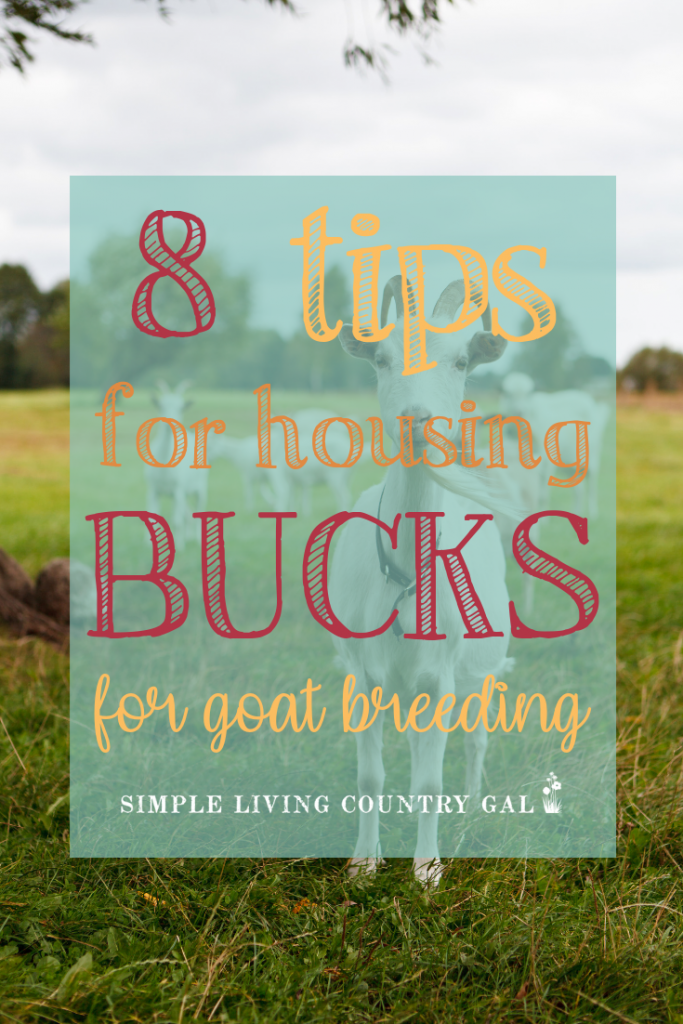
Whether you raise goats for meat or dairy, breeding is something that needs to be considered when mapping out your setup. If you plan to raise dairy goats, you will need to breed those goats in order to ensure you have a constant supply of milk.
No goats yet? Get our top picks here!
In order to breed your does, you either need to raise bucks for breeding or find a buck elsewhere you can rent. If you choose to raise bucks, then you will want to look into housing bucks for breeding goats.
READ: How to Rent a Buck for Breeding
(If you are an experienced goat owner and just want the housing details you may want to skip to the end.)
For us, we learned early on that keeping a buck on our property was the best way to be in control of breeding and kidding times, meaning we can breed on our own schedule. Timing the breeding is important if you are older like I am and you are raising goats with little help.
Let me just say that having five goats all due the same week is not the way to go. Staggering births will keep you and your goats sane.
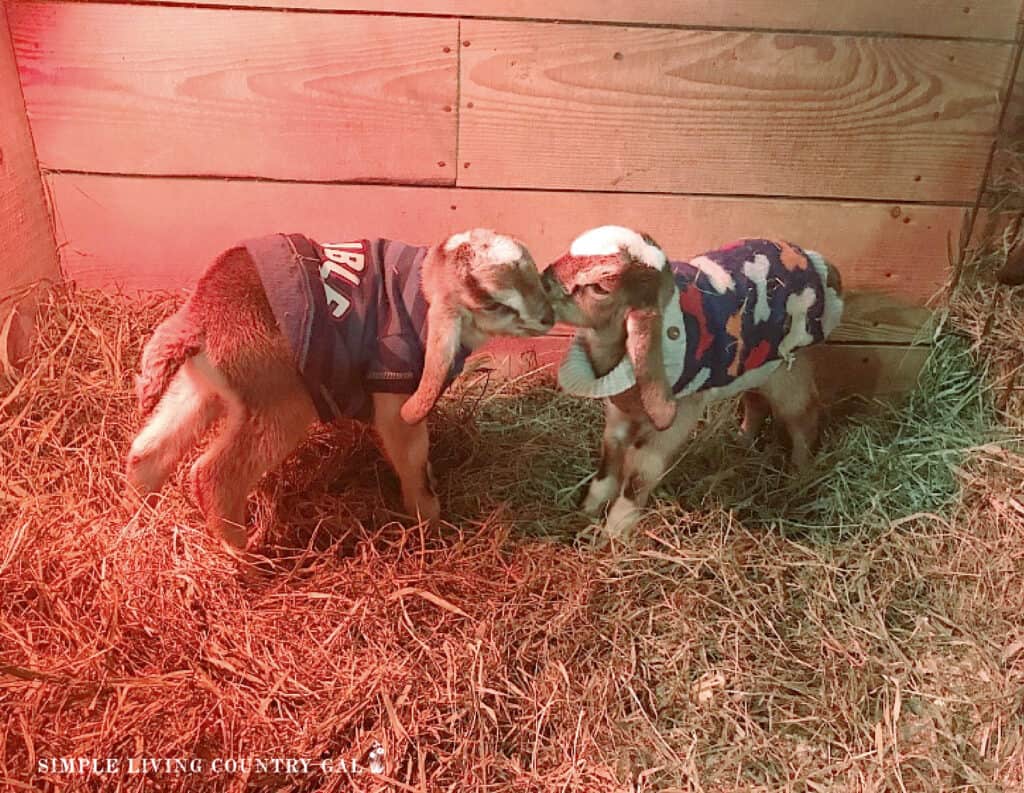
One thing I did not know (and oh boy I wish I did) was the nature of a buck, especially one that is in rut. I planned on housing our buck inside of the barn with the rest of my little herd. I soon found out that when a buck is in rut they transform into, well something else entirely.
You can read more on Buck Rut here.
Characteristics of a Goat Buck in Rut
There are a few things to know before you decide to keep a buck on your property. I am not listing things out to deter you, but knowing what to expect will eliminate any surprises later.
Strong Scent
The biggest characteristic of a goat in rut is the scent. And trust me when I say, it’s a strong one. When a buck is in rut he will “spray” himself (meaning he will spray urine on his face, front legs, and beard).
This odor is what the does are drawn to and this scent will, more often than not, put a female goat into heat. The bad news is, if this smell is anywhere near your barn, it will make everything in that barn smell as well. This includes you, your hay, and even your milk if you have a milking stall in your barn.
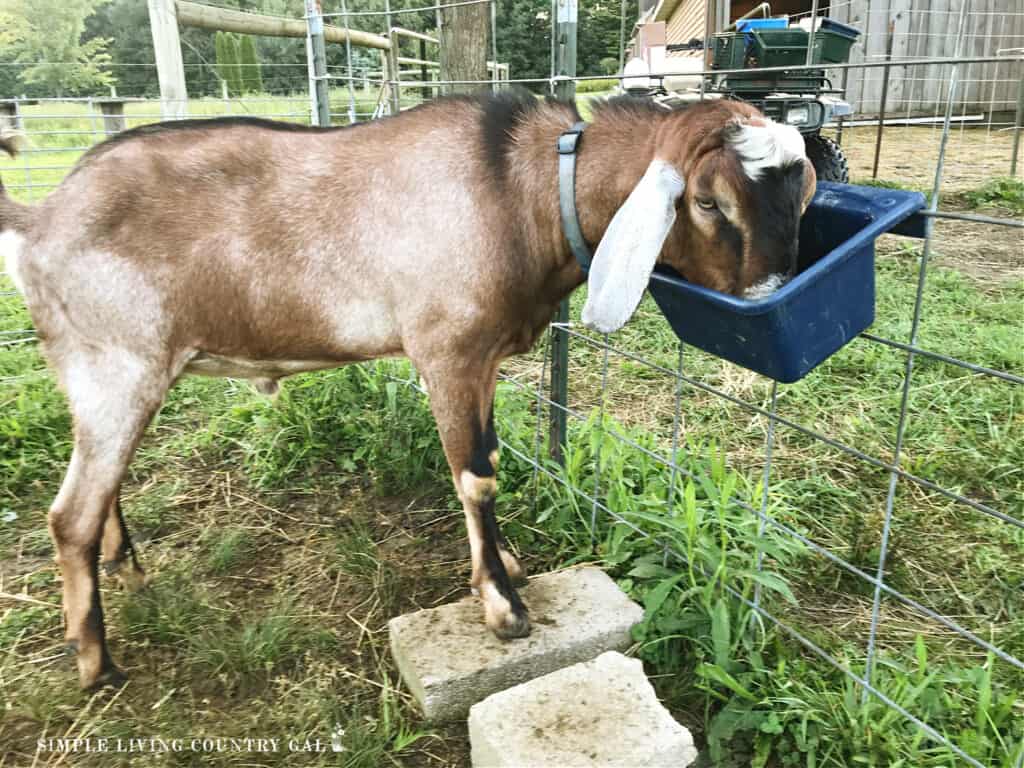
Aggression
Goat bucks in a rut can get a bit crazy, although not intentionally. I have never had a truly crazy buck (knock on wood), but I have heard some stories. If a determined buck wants to get to a doe in heat, he will get to her no matter how secure your housing is.
Housing bucks in a barn with your does may not be the best option as it will only make your bucks crazy, trying harder to get to your goats no matter the cost. Now, that doesn’t mean it can’t be done. I just find it very difficult, so we prefer to keep our bucks outside in a lean-to shelter.
See our shelter tour video below.
Changes in Eating
A buck in rut may stop eating during breeding season. Bucks can get pretty obsessed with does in heat, so much so that they will stop eating and just pace and look for a way to get to them. For this reason, it is important to “know” your goats. This will help you see quickly when something is off, such as significant weight loss.
Dairy Goat Reproduction: Breeding, Birthing, and Milking + Goat Milk Recipes




Noise
Goat bucks in rut can be noisy as they will call out to the female does, letting them know they are nearby. If you have a frustrated buck, they will yell to let you (and your neighbors) know it.
Another noise that bucks in rut make is a blubbering sound. This is a call they do to let the herd and any potential mates know he is looking to breed.
Not all bucks are loud, but we raise Nubians and they are known for their vocalness. To help, we just give our neighbors a heads up that things might get a bit noisy, and they are fine with that.
I am not telling you all of this to deter you from raising your own bucks for goat breeding, but I do want you to go into this with your eyes wide open. These are all things I had to learn the hard way and knowing then what I know now would have saved me so many headaches.
READ: GOAT BREEDS – CHOOSE THE BEST FIT FOR YOU AND YOUR FAMILY
Buck Housing Options
For housing, we prefer to keep our breeding buck out behind our barn in his own shelter. We use a lean-to (three-sided shelter) for his housing and this works great in the warmer months when we are not breeding.
We did not start out with this style, but over the years, I have learned what works best, and for us, this works best.
We also have our buck in a separate fenced in grazing area so he can go out onto pasture throughout the day as he wants. Our buck shelter is far enough away that he is not distracted by the herd, yet close enough to see the other goats.
Let me just stop here and say that goats are highly social animals, even bucks. For that reason, it is best to have a wether (a male goat that has been “fixed” or castrated) in with your bucks. Make sure your wether is a tough goat since they can end up being the target of a buck that is in rut.
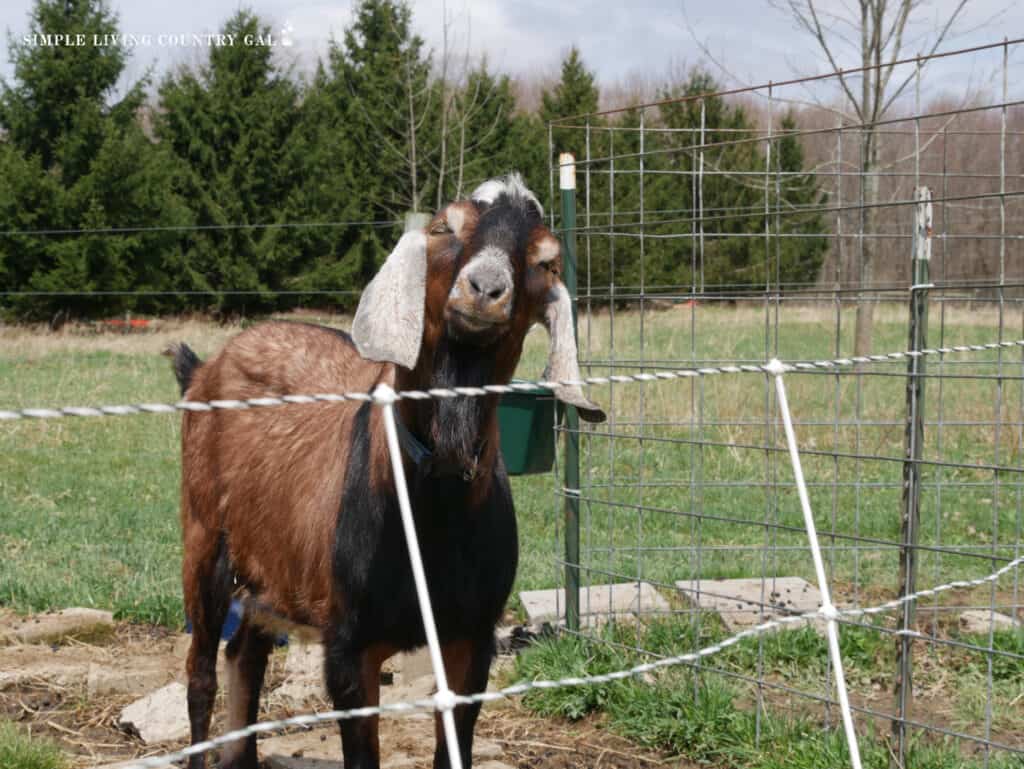
We use high-tensile fencing for the main pasture that our goat kids and female goats have access to; you can see that fence at the top of the photo above. We then use a woven electric fence for the rest of the buck’s pasture area as well as a steel fence panel for the feeding area.
You can see our full setup here. Not the prettiest in the world, but it works great and keeps our bucks inside eliminating accidental breedings in the herd.
You can see how that fence panel works in this video, it has saved me at feeding time for sure!
Lucky for us our buck is not loud, however, I still let my neighbors know that breeding season is coming up and things may get a bit noisy over at our place. Even though our neighbors are not close, this just helps to keep things friendly between us.
Can bucks be out all winter?
Yes, bucks can be outside during the winter, and I have found they tolerate the weather quite well.
If you live in a cold area, do not be tempted to pamper your goats with heaters or coats, as you will alter their ability to acclimate to the weather. Our livestock vet told me that a goat will grow a thick winter coat of fur as the weather cools off. That fur will keep them warm and dry in the winter weather. By letting our goats naturally acclimate to the changing temperatures, they will grow what they need to stay warm all winter.
I have purchased goats that were raised in heated barns their entire lives and what I found was those goats were not nearly as hardy as the rest of our herd. They were fragile with a weak constitution and seemed to be sick often.
Goats raised with coats and heaters do not have the stamina to make it through a cold winter without help. I am not saying you shouldn’t buy a goat raised this way; what you can do is purchase them in the spring so they have plenty of time to get acclimated to a non-heated shelter before the temperatures drop.
Since our bucks are outside year-round (except for breeding season), they all have nice thick coats by winter. They rarely shiver, and their health is hardy and robust. The reason their coats are so thick is that they have time to develop. As the temperatures begin to drop, goats will begin to grow their fur. The colder the weather gets, the thicker the fur.
Lesson? Don’t pamper your livestock. Allow your animals to “harden up” naturally so they can better handle a cold winter with few issues.
What all does a buck need to be housed?
#1. A good, sturdy shelter
You do not need a huge shelter for a buck, but they should be able to stand up inside of it with an area for feed and water inside.
This will keep them out of rain and snow unless they want to be. Also, make sure the shelter has at least three sides with a door or tarp if possible.
#2. Place your shelter away from the wind.
This was another lesson we learned really quick. Put your opening so it is facing out of the wind. For us, that is facing north or east.
Also, it is good to know that Mother Nature is in charge, and there will be times when the wind will blow into your shelter. For those times, you will want to have a door or tarp that you can use to close off the open side, giving your goats a better shelter until the storm passes.
#3. Keep food and water dry
If possible, keep any hay, food, or water inside the shelter. This will ensure that what they eat is dry and free of moisture. You can add a steel hay feeder on the side of the shelter with a mineral bowl for supplements and herbal wormers.
#4. Have a grazing area
You will want to be sure you have enough room for your buck to move outside their shelter. You can use steel panels to close in an area or electric fence netting to give them more grazing.
Either will work fine; just know that if you do not have grazing for your goats, you will need to supplement them daily with good-quality cut hay.
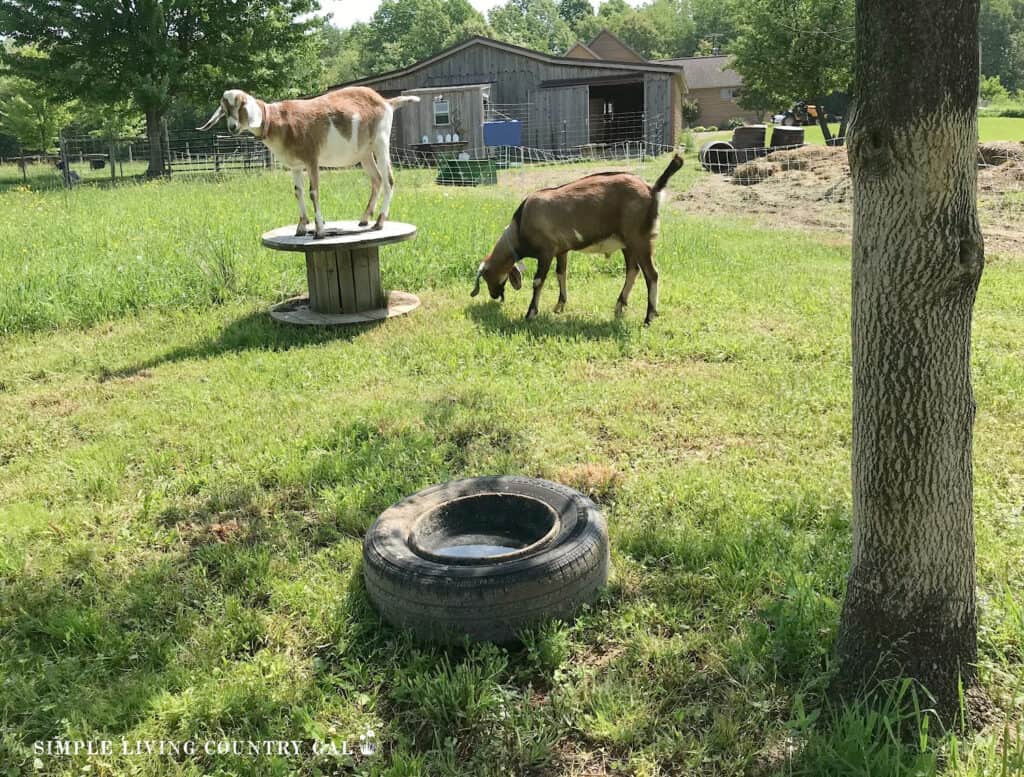
#5. Add concrete or rocks
This one tip is pretty important. Goat hooves cannot be ignored, even on smelly bucks, and overgrown hooves can cause issues if left untrimmed. To help our bucks wear down their hooves naturally, I have several old concrete slabs in my buck’s run. I put them in upside down so the rough pebbly part is facing up.
Goats do not like to be wet, and they will prefer to walk on dry ground rather than wet. When my bucks walk on the concrete slaps they keep their hooves worn down enough that I only need to trim things every few months rather than every month like I do my does.
#6. Have adequate fencing
Like I said before, our bucks are pretty well-behaved. This is lucky for us and not something you can train into a buck. If they are born crazy, odds are they will remain crazy. So, know the mannerisms of your buck and house them accordingly.
There are different types of fencing, and I suggest using electricity if possible. However, steel panels will work if that is your only option. When we first housed our bucks, we only used panel fencing, which worked well for a while. We later upgraded to electric as the shock stopped escape attempts much better.
Electric Fence Netting, 49.6

Steel Fence Panels
These are 5-foot-high steel fencing that come in long sheets. They are pretty easy to move, even for me, and you can use heavy-duty zip ties to hold the panels together, giving you a long sheet for fencing. We then use heavy steel fence stakes (make sure they are heavy duty) that we drive into the ground to attach the panels too, again with zip ties.
When staking a steel fence, be sure to put the stakes on the outside. Goats are very VERY curious and your buck will spend most of the day “standing” on the fence. (see the image above, yes, he does that all day long!) By having your stakes to the outside, you will give extra support to your big buck’s weight.
SLCG ProTip: I suggest walking your fencing line at least monthly so you are always aware of any weak issues that may come up.
More Goat Fence Guides:
#7. Keep things dry
If your run gets really wet and you do not have concrete or rock to put in, then sawdust may be your only other option. (do not use wood, it is very slippery when wet and you can easily hurt your goat)
I will put down a nice layer in the fall when we prep for winter and add to it as needed throughout the winter. Please know if you add too much sawdust or wood chips to your ground you will deter drainage and cause a bigger issue. Make sure you have adequate draining before you begin adding anything.
#8. Close it up in the dead of winter
If you need to keep your buck outside in the winter, you will want to put a cover on the front to keep the snow and wind out of the shelter. You can do this by screwing in a board or a heavy duty tarp that will cover ¾ of the opening. Also, you can place a few straw bales inside to help get your goat up off the cold ground.
It is very important to make sure you have ventilation yet not a draft. Goat urine if full of ammonia and this is not good to breathe in all day and night. You will need ventilation to keep the air fresh. Usually, an opening at the roof of the shelter will give you the airflow you need.
#9. Warm them up when it’s really cold
I like to give our buck very warm water to drink when the temps are at their worst. He LOVES this water and usually drinks it as I pour it.
Another easy way to warm a goat up quickly is with hay and lots of it. Fresh hay encourages your goats to eat, and as they do, their rumen gets to work on the hay, acting like a furnace heating your goats from the inside out. More often than not, a little hay and warm water will take the shivers away in minutes.
Above all things, trust your goat. They are pretty hardy if given a good clean shelter. As long as they have a thick coat and housing that is out of the wind and snow they will do just fine.
If you are not sure of the comfort of your lean-to, crawl inside. I do this every year to make sure things are toasty, comfortable and smelling fresh. More often than not I am pleasantly surprised. With their winter coat, the extra sawdust, and heavy bedding a lean-to can easily house your goats year-round in any weather.
When raising goats having everything on your homestead is convenient.
If you have been nervous about housing a buck for your herd I hope you found some helpful tips and encouragement here. Above all things, education is your best tool. Research, ask questions and visit other farms in your area. Seeing how others house their goats and bucks will be quite helpful.
I was able to visit quite a few homesteads when I first started out, and I took the best from each to come up with my own layout. Try it, and if it doesn’t work, change it. There are no rules with goats, and they will be the first to tell you!!
More Buck Care Tips:
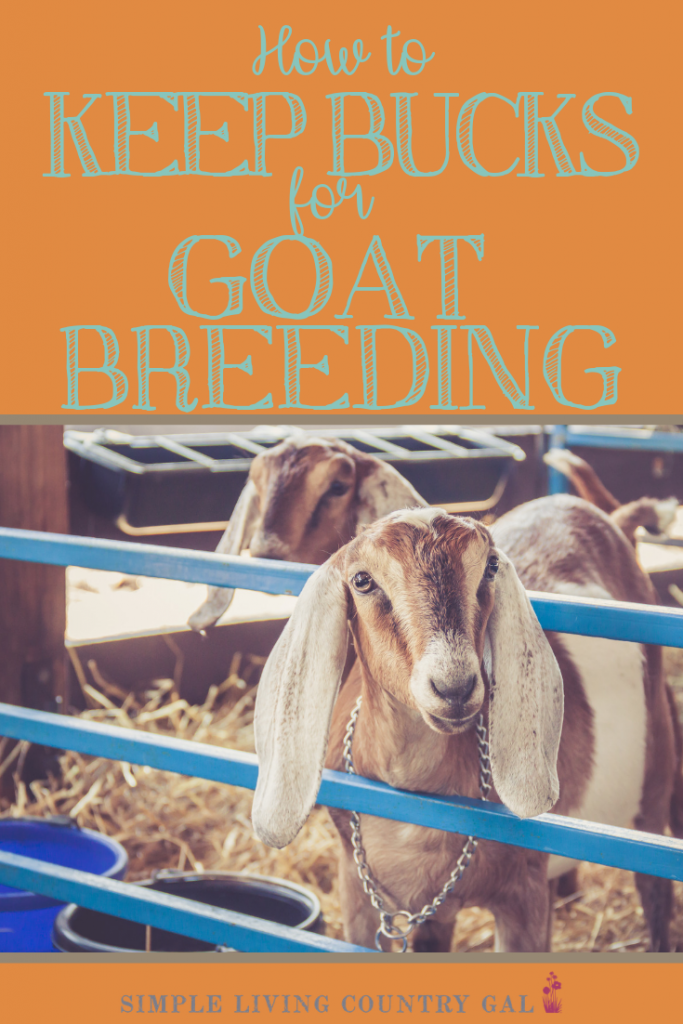

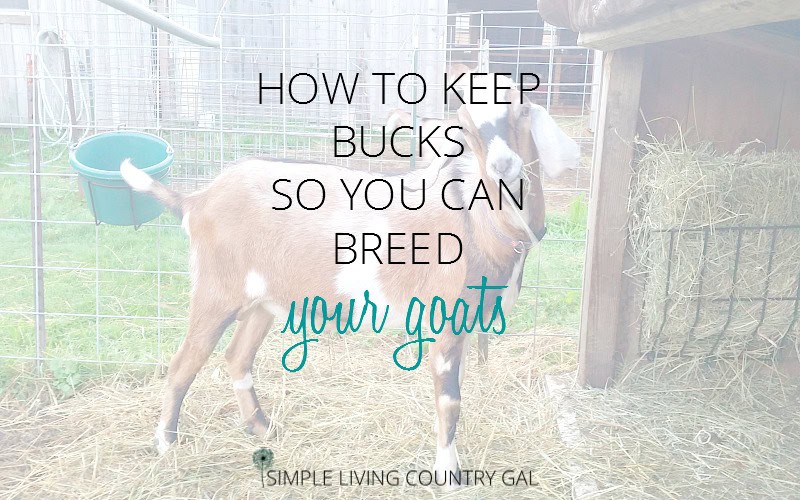






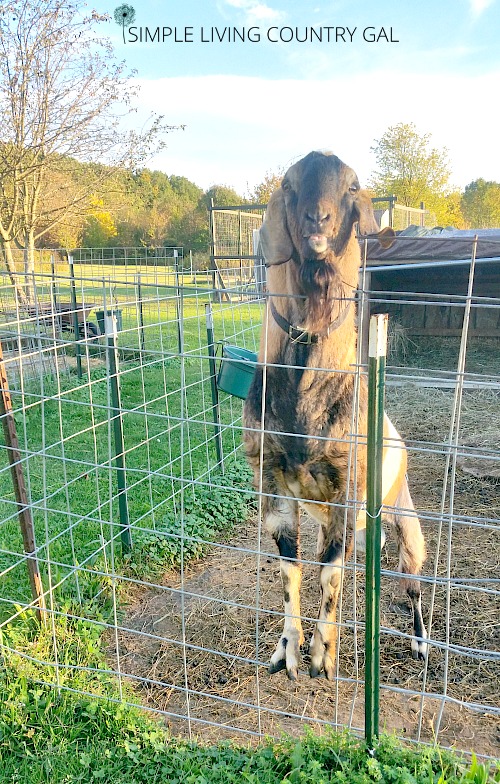
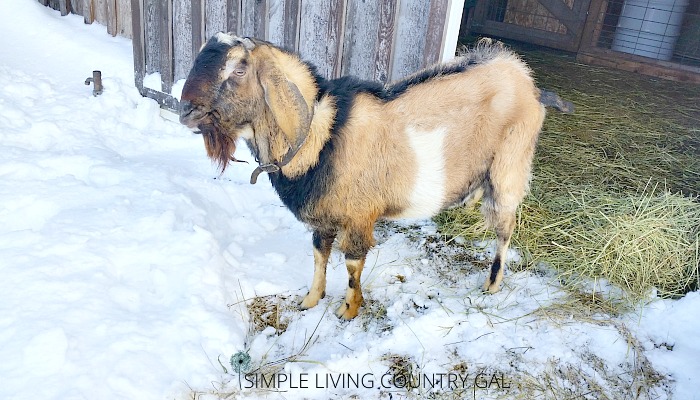
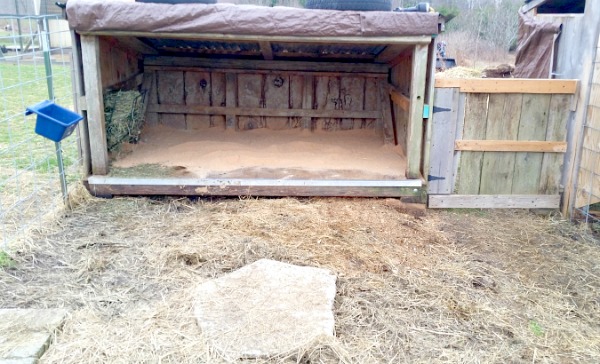
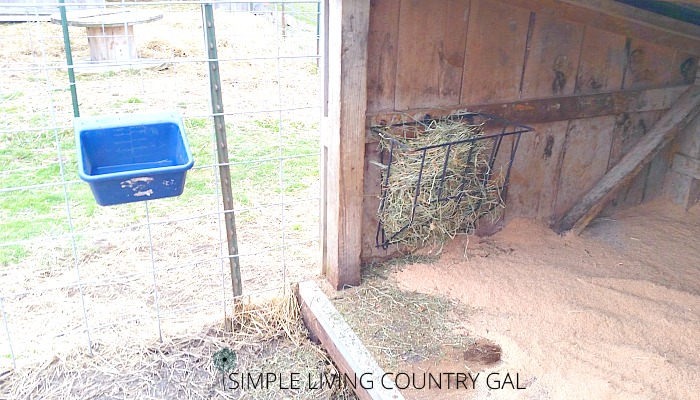
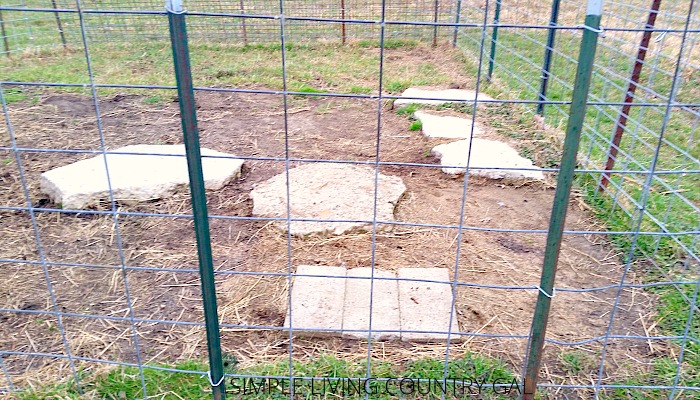


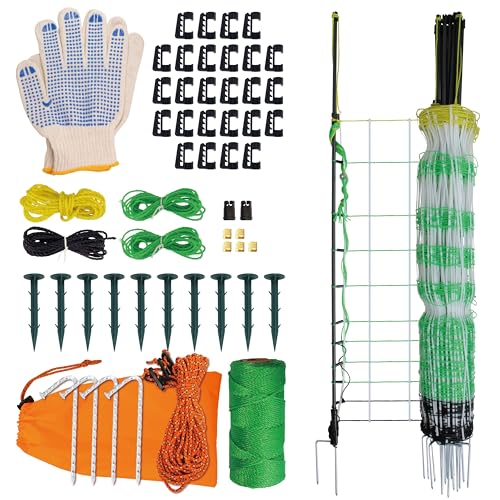
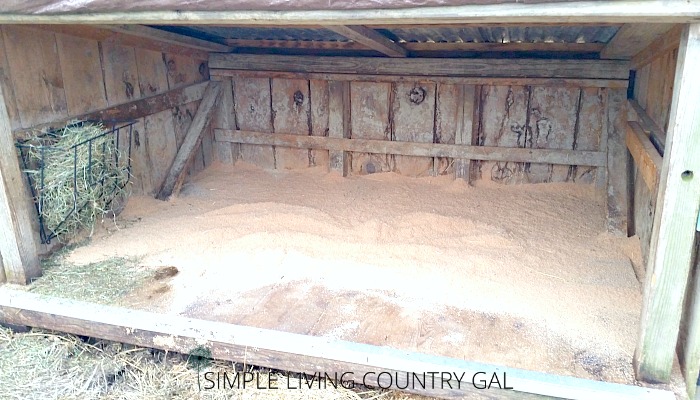
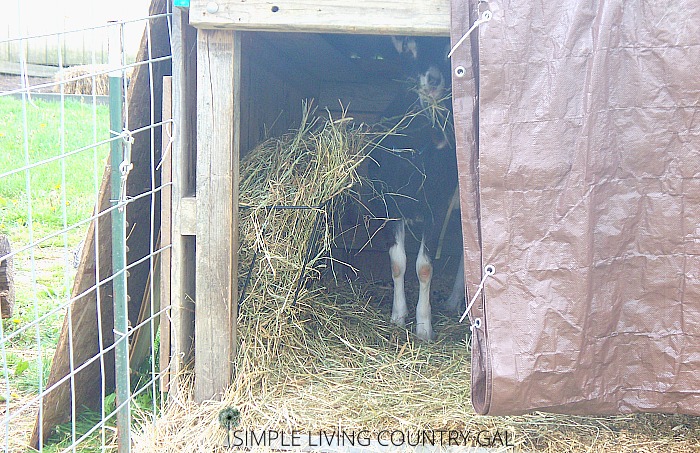
I raise goats and currently have two very healthy bucks. I have been told to not let the bucks breed with their daughters because it may cause birth defects. Have you had any problems with this? I would like to keep one of the bucks and not sale
Hi, Dot,
I do not breed fathers to daughters or any other relations in our goats. We prefer to sell our offspring and only breed non-related does to our bucks. Another option is to have two bucks so you do not have to breed one related animal to another.
For us, it is not worth the risk of delivery, health, or quality issues to breed related animals.
Tracy Lynn
You sound like someone I don’t need to take any advice from. Inbreeding animals is asinine. You need two bucks. Put color tags in their ears. All offspring get the same color as their Dad. One buck gets a white tag and the other gets any other color. Never breed a white tag kid to a white tagged buck, period! What you are producing is bad for the bloodline. DO NOT INBREED GOATS!!!
Hello, Dan,
Thank you so much for this comment and to be clear we have never nor would we ever inbreed our goats or any other animals on our homestead. I did not realize there was a comment here advising of this practice and it has been removed.
I love your advice on tagging and think it will be helpful to so many homesteaders to try.
Inbreeding is not a practice that I advise to anyone for obvious reasons. The health of the doe and kids, quality of characteristics and quality of breed lines is not worth the risk of inbreeding. For this reason SLCG does not recommend it.
Tracy Lynn
Thank you so much for your article! This was just what I was looking for when I was searching for ideas for a pen for my 2 fainting goat bucks. I have the perfect spot for it, and they will be able to see their goat friends. I’m so happy I came across this when I did!!! Looking forward to reading more!! -Colleen-
Hi, Colleen!
So glad you found this post helpful. Keeping bucks can be tricky but as long as you put them in a safe and secure home you should be just fine!!
Tracy Lynn
I have 2 saanens that are 8 months old,very healthy, so you think I should wait until they are over a year old to breed? I have read and been told that even bottle raised bucks that have always been docile, can be dangerous during rut, I am in an area where I have not been able to find stud service when I do want to breed.
Yes, Carolyn, even docile bucks become a bit aggressive during rut. I always keep my distance during that time just to be safe. Sturdy housing is the key to avoiding issues so make sure you have things in place before rut begins. With that being said, I have never been in any danger with my bucks. Being hands-on with them from day one is key to keeping things safer during rut.
Even though 10 months is the recommended I prefer to wait until after a year to breed my gals. This is just what is comfortable for me. I know quite a few folks that breed at 10 months. If your does look strong and healthy you should be fine. Use your best judgment.
Good Luck!
Tracy Lynn
I loved your article! I have two does and a wether (Buddy). He is not nice to the girls at all! I found a very handsome buck that I would like but then what about Buddy? So now I feel ok about Buddy living with a new buck.
Yes, Buddy can absolutely live with your buck, but be ready for some adjustment time. At first there will be some fighting and head butting and that is okay so don’t worry if you see that happening. Adjustment can be scary with animals, so just be patient and you will be fine!
Tracy Lynn
This was a fabulous post. Thank you!
So glad it helped, Becky!
Is a goat house also called a pen?
Yes, it is, Richard. Depending on where you live the name for it will be different. 🙂
I have two Nigerian Dwarf bucks who are brothers. Can i keep them in the same pen during rut or should we keep them in separate pens that are close together? Thanks!
Hello, Jennifer!
If they get along you should be just fine. I keep more than one buck in rut together and have not had problems, just be aware that they might be more rambunctious.
If it were me I would keep them together.
Good Luck!
Tracy Lynn
How far away do you need to keep the male from the females? I woukd imagine too close and the smell of them in heat woukd make him a bit crazed. I was thinking a wether for company so it wouldn’t matter if he could see the females or not. Thanks, very useful article. We are thinking about raising sheep for meat, also. Have you heard anything about keeping the male goat and sheep together?
It really all depends on the housing and how solid it is to keep your bucks contained. Your doe’s scent will carry for miles so there is really no exact way to limit that, however, if they can see the girls and you have a very determined buck that might be something to consider.
Our buck was just a few yards from our does and he was able to get out once, we made a few adjustments allowed him to get a “zap” on his nose to remind him of the pain our fence would give him and we had no more issues after that.
We do have a wether that lives with our buck, but during rut we keep him separate. A buck in rut will mount anything and our wether was getting pretty beat up. Once we start breeding our buck would then head ram our wether because he saw him as a “threat”. Now we keep our wether separate until the does are bred or our buck is done with rut. Then everyone goes back to their regular spring/summer homes.
I hope this helps!
Tracy Lynn
Thank you for this article–it was very helpful. I have been reluctant to get a buck because of the stories you hear about them, but we are getting one soon and this made it seem “less yucky”. I also didn’t want him smelling up the barn, but now know we can have a run in for him and he will be fine. Happy farming!! Amy
Hi, Amy!
Just know that all bucks are NOT created equal. You can have a buck that smells just a little and another that smells a whole lot. Just keep that in mind and be sure to have separate clothes when you do barn things to keep that smell out of your house. 🙂
Good Luck!
Tracy Lynn
Hi We have a small hobby farm. Presently have one doe with two kids, two and a bit old doelings we plan to breed this fall and a year + old buckling who is father of the kids (that are destined for a new home) and we will breed to our doelings. We also in the same collection have a wether, two alpaca, a llama and a sheep. Our buckling has been living separately but adjacent to the herd since the kids were born. The kids have found a way to visit their “dad” and move freely between both paddocks without any problems. Only in the last week or so has the Buck decided to become “Rammy” with us. He will take a run at us without warning. You can be scratching his back one minute and getting hit in the backside the next. I hate not being able to comfortably turn my back on him. I am wondering could this behaviour be related to “Rutt”? If any of the does are coming into season would this make his behaviour change greatly? Until now we haven’t kept a buck. We just borrowed. He seemed fine for so long but now is he jsut “growing up”? He was always a bit push when in with the herd, He usually had a couple in the herd he targeted more. I am wondering if being adjacent to the herd is the problem? He seems more content when it is feeding time etc to be right on the other side of the fence from the herd. I feel bad because they are a herd animal that he can’t be with the herd. I am open to any input or suggestions on how best to manage him.
Oh, you’re absolutely correct. When a buck is in rut they tend to get a bit pushy. This is usually only temporary and should go away after breeding season is over or all of your does have been bred. No matter how friendly your buck is, you should never turn your back on him when he is in rut. 🙂
Our first buck was more like a pet, I absolutely adored him and he would let me do anything to him without complaint. But when he was in full rut and I still had does that needed to be bred, I really had to keep my distance. Don’t worry your sweet buck should come back to you soon!
Good Luck!
Tracy Lynn
Thanks for your article. I have just started with goats. I have two does a little over a year old and a buck now about 6 mos. The one doe was definitely in heat a couple days ago but doesn’t seem to want his attention now. However, he is chasing her all over even bothering her when she is lying down. I had intended to let them all run together without a separate pen for the buck. I have a hillside of about 1/2 acre for them all to roam in but I don’t want this buck to wear out the does when he is in rut. I had intended to have them run as a herd. Any suggestions? Thanks
Once the buck has bread the does and they are no longer in heat, he will not bother them anymore. I let my buck run with my does all winter long unless he gets overly aggressive, then I do need to separate them, but this doesn’t happen too often.
Can a buck share a fence line with does?
Hello, Hollie!
Here’s the thing with bucks. If they are in Rut and are near a doe that is in heat they will do all that they can to get to those does. But, that all depends on their personality.
Our first buck was just fine sharing a fence that was a 5′ cattle panel attached to stakes that were securely set into the ground. Our next buck would jump that 5′ fence without thinking twice, so we had to add another 5-foot panel to that first one using zip ties to connect the two pieced together.
We eventually had to separate our herds altogether keeping a secure fence for each and a good 15 feet between fences.
My final advice is this, plan for the worst and hope for the best. Assume your buck will do anything he can. to get to your does and put into place the most secure fence you are able to.
Good luck!
Tracy Lynn
If you don’t want your doe pregnant, do not share a fence line. They will bread through a wire fence.
Great point!
Thank you so much for this great article! I am a new goat mom (well they are coming next month) I have 2 does coming July 3rd (one is the mom to the other) and 1 buck and 1 wether coming July 31st. I was thinking I would keep them all together in the barn with separate pens for the boys/girls, however after reading this in realizing real quick I don’t want the boys in the barn. My question is can I build the boys a house outside and allow them to share a run with the does? Or do they need their own run altogether? My buck will be wearing an apron, but is that enough? Both of my boys and my young doe were all born in May/early June so they can’t be bed until next spring. Would love your opinion on this and any advice you could give me!
I totally understand your concerns, Melissa but honestly, it all depends on your buck. My first buck was a total gentleman. I raised him from a baby (not bottle-fed) and was constantly hands-on with him from day one. This really helped him to see me as the boss and listen to my commands more willingly.
With that being said….all rules are out the window when you have a buck in rut and a doe in heat.
If you do not want accidental breedings go overboard with separation. However, you should not need to go crazy when your buck is this young. So your fencing can grow with your buck as you see where you need to improve and where you are set.
Tracy Lynnm
Very useful article. We have 2 wee Does around 4 months old and have just got a 7 month old Buck. At present they are in the pen together, is this OK? When will the does come into heat and when is the Buck at sexuel maturity? When’s best to separate them as I don’t want my girls pregnant too young. Appreciate your help as I am very new to keeping goats x
Hi, Lisa!
I myself would not keep bucks and does together after the age of 12 weeks. It is always better to be safe than sorry!
Tracy Lynn
You have a good article but I would like to add that I would use something stronger than zip ties to hold the pen together. My buck would never stay in. We have everything put together with strong wire and also have electric around it. I have had bucks that can jump a 5′ fence and have had bucks breed does thru the fence. That being said, I do have 5 bucks in one pen and they all are anywhere from 250 lbs to over 300 lbs so the can do lots of damage to a fence and I won’t have a mean buck, it is way to risky but yes you still have to remember they are still a buck and can be rambunctious. Thank you so much for this article.
Thank you for your input, we have always used zipties and have never had a problem with the fences not being secure. The stakes are in the ground pretty far and that is a huge part of the stability. We also only have one buck, can’t ever imagine what it would be like to have 5!
Metal ties will probably be more secure with a fence housing a group of bucks or a determined buck.